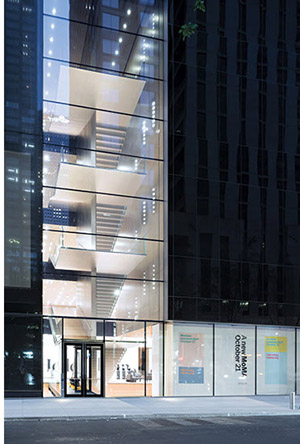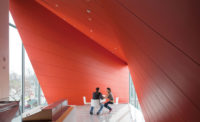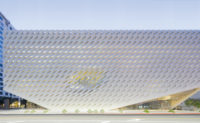By now it would seem that the opening of a new expansion for the Museum of Modern Art in New York (MoMA) would be greeted with a stifled yawn. After all, the museum underwent a major renovation and addition 15 years ago. Before that, in 1984, the museum was also enlarged, and smaller additions had taken place in 1964 and 1951. All of this activity occurred on West 53rd Street, after MoMA’s first purpose-built structure was completed there in 1939. Manifest destiny seems to guide its westward expansion, transmogrifying the block from townhouses and low-rise cultural buildings to a canyon of residential towers (two of which helped pay for the museum’s expansions through a special legal mechanism). After Philip Goodwin and Edward Durell Stone’s 1939 foray, other architects have left their imprints, including Philip Johnson, Cesar Pelli, Yoshio Taniguchi, and now Diller Scofidio + Renfro (DSR) in collaboration with Gensler.
Additional Content:
– Technical Sidebar: The Blade Stair
– Credits & Specifications
Unlike Lincoln Center, where DSR brilliantly reworked a 1960s modernist complex, the architects’ efforts here are subtler and exhibit less panache. Nevertheless, they have shown a sophistication and skill in pushing boundaries of current techniques and materials to improve what they confronted.

Under the leadership of MoMA director Glenn Lowry, this latest expansion brings the museum’s total size to 708,000 square feet, up from 606,000 square feet. Though museum audiences are strong (MoMA attracted 3 million visitors in 2018, almost double the number 20 years earlier), the question remains whether continual growth can always accommodate the multitudes, giving a sense of orientation to the visitors while also encouraging the intimate contemplation of works on display.
Why expand at all? First, MoMA keeps adding to its collection, acquiring contemporary art, for which there is no end date. Second, it needs room for display; with the current expansion, the museum will still have 90 percent of its 200,000 holdings in storage. MoMA now plans to avoid burying its holdings by rotating at least one-third of its permanent collection onto walls of some 60 galleries every six months. Third, an expansion tends to bring even more traffic: the museum projects 3.5 million visitors in 2020.
Nevertheless, meandering through cavernous museums is hard on visitors. The modernist plan, with neutral, loftlike spaces opening onto each other, can be more confusing to navigate than traditionally classical structures, with their enfilades of galleries guiding circulation, and a central atrium or stair orienting museumgoers. To be sure, MoMA’s 1939 structure was loftlike, but galleries took up less than half of its 109,000 square feet.
Today, with the completion of the DSR expansion, two primary questions occur: which way do you turn when you first enter the museum, and how do you find such legendary attractions in the collection as Monet’s Water Lilies, Van Gogh’s The Starry Night, or Picasso’s Les Demoiselles d’Avignon? Frankly, the answer is to use a map or ask one of the many guides. The permanent collection is still organized generally in a chronological fashion, with artwork from the 1880s through the 1940s on the fifth floor, from the 1940s to the 1970s on the fourth floor, and pieces from the 1970s to the present on the second floor. (The third floor contains a few galleries and a lot of service space.)
In these loose confines is a mix of media, disciplines, and styles with newly acquired art by women, people of color, and different cultures added to the familiar modern canon. As for the half dozen architecture and design galleries, they are now sprinkled throughout the building instead of clustered in one area.
In order for DSR and Gensler to stitch old and new galleries and public spaces together, the architectural team made several very visible moves and many subtle, surgical ones. A first phase, in 2018, focused on remodeling and renovating parts of the 1939 Goodwin Stone building and the 1964 wing by Philip Johnson to the east. The famous “Bauhaus stair” of 1939—named for its resemblance to the stairs Walter Gropius included in the Bauhaus building in Dessau (1926)—was fully reconstructed. (It had been removed in 1984 and then was partially put back in 2004.) Also, in the first phase, DSR added a lounge facing the sculpture garden, opening up a view that had been blocked.
The second phase, which opened to the public October 21, remodeled much of the Taniguchi-designed lobby on 53rd Street, and extended the galleries toward Sixth Avenue through properties acquired over previous decades. The architects made the existing entry space into a double-height hall marked on the street by a sleek stainless-steel canopy, 42 feet long and cantilevering 26 feet over the sidewalk. The lobby has been widened to include ticketing kiosks, seating, and, most dramatically, a retail store sunk one level. Daylight pours through the expansive, frameless structural glass on the street into this lower space, which is completely open to the lobby. Wide blackened-steel stairs seem to float from the main level down to the shop: the crisply detailed run cantilevers from a stringer at one edge and transfers forces to a stringer at the opposite edge at a midpoint landing.
But this stair is only an amuse bouche. To the west, at the south corner of the original Taniguchi block, DSR/Gensler carved out a narrow 21-foot-wide circulation space that houses the Blade Stair and an elevator bank. The Blade Stair separates the Taniguchi block from a completely new building to the west, which the architects designed in the footprint of the former American Folk Art Museum. After buying it in 2011, MoMA decided to tear down the multilevel 40-foot-wide museum to keep the floor-to-ceiling heights on the second, fourth, and fifth levels of the Taniguchi building the same throughout the galleries it now owns in the Jean Nouvel–designed condominium apartment tower on the west side of the expansion.
The appearance of the slender infill structure is not without irony: the highly crafted Folk Art Museum, designed by Tod Williams Billie Tsien Architects (TWBTA) in 2001, was only 13 years old when it was razed. The public debate about the museum’s decision has made the destroyed artifact one of TWBTA’s most famous works. Architectural cognoscenti note that the building is named for developer Jerry Speyer, chairman emeritus of MoMA’s board, and his wife, Katherine Farley, for whom Williams and Tsien designed a townhouse on the Upper East Side.
The new Speyer Farley building allowed DSR to embark on its signature sectional play of spaces. The stack of vertically interlocking galleries of different heights includes the 26½-foot-high Projects Gallery at the rear of the Street Level Gallery; the 23-foot-high Daylit Gallery at the front of the second floor, and finally the 31-foot-high Studio for performances on the fourth floor. This stack is topped by the Terrace Café on the sixth floor, where Kerstin Brätsch’s installation in the 85-seat dining space aspires to a slightly louche effect with colorful art and a pamper-me-pink film over the south glass wall. The Speyer Farley Building is intended to be open when the rest of the museum is not, so visitors can enter the Street Level Gallery with no admission, then the current architects pushed for the high level of detailing needed for their stairs, entrances, and other features. It no doubt helped that both DSR and Gensler are located in New York and were relentless about the craftsmanship and application of materials.
It is not clear if the new expansion solves the problem of disorientation and museum fatigue since, so far, comments from the public are still based on lack of familiarity with the new setting. Over the last 80 years, MoMA has turned itself from a small Modernist statement into a preeminent institution devoted to modern and contemporary art. Now a behemoth, it seems to function at this early point as a spacious and serene, if anodyne, machine. What about the future? In 20 years—time for the next expansion, we would guess—the museum will be celebrating its 100th birthday. So, where can it grow? If desire is there, we’re sure MoMA will find a way.
CreditsArchitect: Diller Scofidio + Renfro — Elizabeth Diller, partner in charge; Charles Renfro, Ricardo Scofidio, Benjamin Gilmartin, partners; Alberto Cavellero, Zoë Small, Kevin Rice, Chris Andreacola, project directors; Andrea Schelly, Michael Hundsnurscher, project architects; Chris Kupski, Daniel Markiewicz, Jess Austin, Mario Bastianelli, lead designers; Lilian Fitch, David Mayner, Jonathan Parker, Sean Rowe, Heng-Choon Leong, Charles Blanchard, Fareez Giga, Sanny Ng, Derrick Benson, Ben Johnson, Roy Peer, Jason Buccheit, Chris Hall, Amber Foo, Jack Solomon, Michael Robitz, Barry Beagan, Alice Colverd, team. Gensler — Madeline Burke-Vigeland, principal and project director; Ambrose Aliaga-Kelly, principal and technical director; David Adler, Thomasz Bona, Kristian Gregerson, Mariano Ortiz Ratkovic, Michelle Neary, Mina Onar, Vivian Schapsis, Wendy Tang; John Bricker, Mieko Oda, Eileen Moore, Jose Troconis, Jocelyn Mastroianni, Adam Tanski, brand and graphics.
Engineering: Severud Associates (structural); Jaros Baum & Bolles (m/e/p,fp)
General contractor: Turner Construction
Consultants: Retail: Lumsden Design Lighting (Public Spaces): Tillotson Design Associates Lighting (Gallery Spaces): Renfro Design Group Façade: Heintges Consulting Architects & Engineers P.C. Environmental Design: Atelier Ten Security: DVS Security Audiovisual, IT, and Acoustical: Cerami & Associates Vertical Transportation: Van Deusen Associates Theater Planning and Design: Fisher Dachs Associates Theater Audiovisual: Boyce Nemec Designs Waterproofing: Vidaris Food Service: Cini-Little International, Inc. Signage and Wayfinding: Gensler and Wkshps
Size: 708,000 square feet
Cost: $450 million
Completion date: October 2019
|
SpecificationsMetal panels, curtain wall, Stainless-steel canopy Frener + Reifer, Pohl (metals) Moisture barrier: Grace Curtain wall: Frener+Reifer Stainless Steel canopy: Frener+Reifer/EMPL Germany Stone: Continental Built-up roofing: Kemper, Laurenco
Flooring JJ Curran (tile); Armstrong (resilient)
Paints and stains Benjamin Moore, Sherwin-Williams, Farrow & Ball
Acoustical finishes Pyrok, BOH (ceiling tile); Armstrong
Downlights Nulux, Optolum, Eklipse, BK Lighting, Lucifer, Selux, Gotham, USAI
Custom track light LiteLab
Exterior lighting Apure, Nulux, 12Systems, BK Lighting
Glass Sedak
Titanium fittings and stainless-steel rods TriPyramid
Doors Entrances: Custom glass doors, Frener+Reifer Metal doors: Custom, Frener+Reifer Revolving doors: Dorma-Kaba
Hardware Exit devices: Blumcraft, CR Lawrence Pulls: Blumcraft
Interior Finishes Acoustical ceilings: StarSilent: Pyrok ; BOH ceiling tile: Armstrong Suspension grid: SkyDeck tension Wire Grid : IA Stage Demountable partitions: Cabinetwork and custom woodwork: Miller Blaker, Modern Woodcrafts Paints and stains: Benjamin Moore, Sherwin-Williams Wall coverings: Paneling: Millwork paneling: Miller Blaker; Metal Paneling: MCohen, Jonathan Metal & Glass Plastic laminate: Miller Blaker Solid surfacing: Continental Special surfacing: Floor and wall tile: JJ Curran Resilient flooring: Armstrong Flooring
Lighting Downlights: Nulux, Optolum, Eklipse, BK Lighting, Eklipse, Optolum, Lucifer, Selux, Gotham, USAI Custom Track Light: LiteLab Exterior: Apure, Nulux, i2Systems, BK Lighting, Dimming system or other lighting controls: Lutron
Conveyance Elevators/escalators: Liberty, Custom Cabs |


















Post a comment to this article
Report Abusive Comment